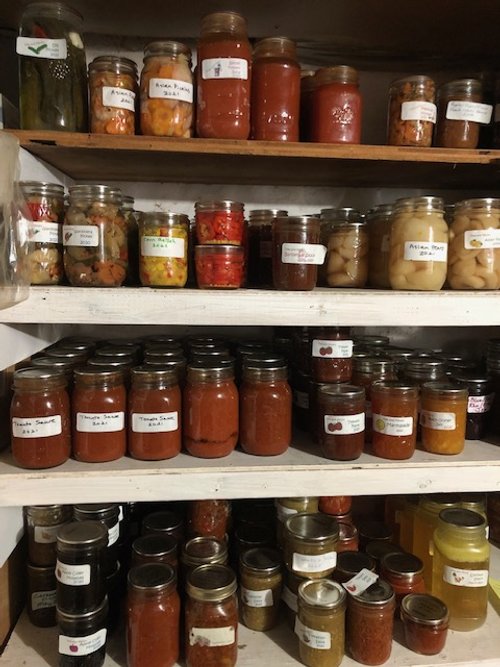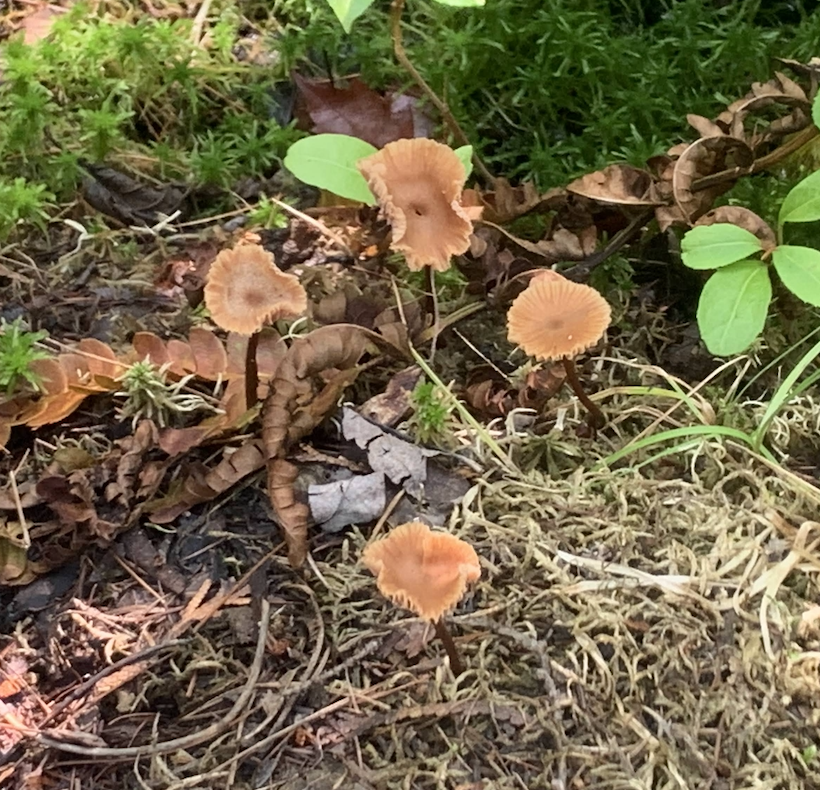Harvest thoughts
Greetings, readers!
I hope you’re enjoying this beautiful time of year. How lucky we are to live in a place where nature puts on so many dazzling seasonal displays for us.
Marc and Kris’s vegetable garden seems to be breathing a contented sigh as it slowly beds down for the Winter.
Turkey daycare visits every morning, as if to say “It’s time to open the gate and let us in for a spot of gleaning.”
Nature’s bounty
Some of our members have been busy laying down the fruits of a bumper harvest. Myra and Tom sent us these photos as they came to the end of their annual canning extravaganza. So much work captured in all these jars!
Shallot and garlic harvest
Heirloom corn to be ground up for corn meal and polenta
No words for this
Dried beans from the garden
Tom makes these brooms from broom corn that we grow.
Some late-season pickings: Asian and European pears, tomatoes, and jalapeños.
Talking of nature’s bounty, Therese has shared some more recollections from her first canoe camping trip. No campers were injured during the making of this story.
Mushrooms ahoy!
by Therese
If you’re a fan of apocalyptic science fiction, as I am, you might have seen a series called “The Last of Us”. It tells the story of a pandemic caused by a global fungal infection that causes people to transform into your typical zombie but with large mushroom-like appendages. It’s very well done, and I highly recommend it if you like that sort of thing.
What I don’t recommend is being dragged along on a mushroom hunt when the events of the series are still fresh in your mind. Despite being fond of proper mushrooms from shops, I couldn’t shake off the thought that even that innocent looking produce is the fruit of gigantic underground networks of fungi that are just waiting for us to drop our guard.
But I had no choice on our Summer canoe trip, as I found myself miles from anywhere with an enthusiastic gang of mushroomers. The object of the exercise was to find things called “black trumpets”, which Marc and Mathew assured me were delicious (I had no intention of finding out while I was so far from a hospital). We did eventually find some, but not before we encountered some other deadly alternatives.
With the help of Wikipedia and other sources, I’ve made an attempt to identify some of the mushrooms we came across. Please bear in mind that I DO NOT KNOW ANYTHING ABOUT THIS. DO NOT TRUST ANYTHING I SAY. If you, gentle reader, can help me out and correct any mistakes, please email info@kawarthacommons.ca. There would be a guest post in it for you if you’re interested.
Having said all that, I’m pretty sure of this first one. Many dangerous things are beautiful, and the destroying angel is no exception. The clue’s in the name. Wikipedia says that these innocent-looking things account for the overwhelming majority of deaths due to mushroom poisoning. Symptoms don’t appear for 5 to 24 hours, by which time the toxins may already be absorbed and organ damage is irreversible. As little as half a mushroom cap can be fatal if the victim is not treated quickly enough. The best bit is that they are often mistaken for edible mushrooms when they’re young. Lovely.
Our next find is the cousin of the destroying angel - the death cap. Unfortunately, these taste quite nice and younger ones can smell like honey, which seems extra devious to me. The mortality rate from ingestion is around 10–30%, but those who survive only do so because of advances in medical science, and can still suffer from life-limiting conditions. Don’t even touch it.
This photo reminds me of my grandad’s stories about fairies living under toadstools at the bottom of the garden. I didn’t see any fairies this time though.
I think this one is called Jackson's slender caesar. It is edible, but Wikipedia doesn’t mention whether it tastes good. The fact that it’s often mistaken for its toxic relatives is enough to put me off ever trying one. But it shone like a little burst of sunshine on the forest floor.
One myth that Wikipedia has busted for me is that a mushroom is safe to eat if it looks like it’s been chewed by some other creature. Chances are that creature is lying around in a coma somewhere nearby.
These may or may not have been chanterelles. Marc and Mathew did confidently pick some later on, but these particular ones could also have been either false chanterelles, which are mildly toxic and will cause gastric discomfort, or jack-o-lanterns, which are highly toxic and can cause severe stomach upset. They really were very pretty though. Apparently real chanterelles smell like apricots.
These mushrooms reminded me of the frilly knickers that were all the rage on court at Wimbledon in the seventies. They seem to be trying to outdo each other with their folderols (there’s a word I haven’t used in a sentence for a while). They are edible, but take care. Wikipedia says this one’s common name is the deceiver, because its appearance can vary so much, and it’s easily confused with “potentially lethal small brown mushrooms”.
We were lucky to come across these violet webcaps, described by Wikipedia as more striking in colour than in flavour. It seems that they’re considered edible only because nothing bad happens to you if you eat them. Another source says that there are at least two sound reasons for not gathering this species. The first is its rarity, and the second is that quite a lot of their lookalikes have proven track records as deadly killers. Enough said. Admire them, consider yourself fortunate to have found them, and leave them where they are.
The swamp death angel is, as the name suggests, another mushroom to avoid. You’ve probably guessed that it’s also a cousin of the destroying angel, with the same habit of lulling you into a false sense of security before it destroys your liver and kidneys. The marking on top were very striking though.
Eventually, we did strike (black) gold. This is what black trumpets look like in the wild. Wikipedia has only good things to say about them - they are “edible and choice”, and are prized by gourmets. They even taste a bit like black truffles when dried. I admit I was curious, but not quite curious enough. One Weird Thing is that in France, Spain, and Haiti they are often called trumpets of death or trumpets of the dead, because they are the colour of trumpets that people imagined the dead might play in the Underworld.
And here’s what they look like in the pan. Marc realized we should have brought along wine, garlic, and cream. Something to remember for next time. As I said, I wasn’t brave enough to try them, but the rest of the group did and survived to tell the tale (even though I’m the one telling it).
I learned a lot on our mushroom hikes - the most important of which is that it’s really, really hard to distinguish between poisonous and edible mushrooms, as they often look almost identical. But as I look through my photos now, I have to admit that these fruits of the forest are stunningly beautiful in a hundred different ways. Just don’t turn your back on them.
KCC Community Fundraising
Submitted by Judy
In December, 2022, KCC membership donated $3,000 to support two local grassroots charities faced with a growing crisis.
We felt that together KCC could raise the profile of community design and impact housing supply in Peterborough by supporting local initiatives to end homelessness.
Peterborough, like many communities in Canada, has been suffering from the effects of the rising inequities in our social structure, commodification of housing and a serious shortage of mental health services. This has resulted in an unprecedented number of citizens finding themselves caught in the opioid trap, and all without a safe place to live, in overflowing shelters and tent encampments.
Two organizations have been formed alongside the City’s standard social services to attempt to cope with this crisis: PATH and One City.
Peterborough Action for Tiny Homes (PATH)
The vision for PATH was formed in 2020 by a group of largely older women activists, to create a community of sleeping cabins with shared facilities and wraparound mental health services in partnership with the Elizabeth Fry Society and a host of volunteers. Starting with fifteen 8x10ft cabins (10 of which are ready for assembly) this will be a safe place for people to sleep, keep their meagre belongings, and have communal access to showers, laundry, toilets, and meals. A site was negotiated with Habitat for Humanity starting July 1/2023. This will provide transitional housing and healing as a base for residents to stabilize their lives and move forward to permanent affordable housing and hopefully gainful employment.
If you’re local to Peterborough, you might like to know that the Peterborough Concert Band and PATH are joining forces to present a benefit concert on Sunday October 15, from 3pm to 4:30pm, with a reception to follow.
Waterloo, Kingston and Hamilton have similar projects. For more information, to donate, or volunteer, visit https://pathptbo.org/home/.
One City
One City currently owns 4 houses and manages 7 locations - 4 for private landlords, and 3 locations for other non-profit agencies. This provides 30 places to live for individuals in the community.
One City works with external organizations, volunteers, and their own staff to provide a range of supports for tenants, including maintaining housing, connecting with the community, accessing health services, furthering their education, increasing wellbeing, and supporting individuals in whatever goals they strive to reach. One City also provides community education spaces where people can learn, engage, and act together. They will host pay-what-you-can workshops, courses, and events focused on creating community, thinking about what it means to be good humans and neighbours, and providing practical skills around advocacy and community action.
One City also partners with Haley House, a halfway house for individuals coming out of federal prison who are palliative or struggling with significant health concerns. This home, founded by Dan Haley in 2016, can provide housing for up to 10 individuals at a time. Residents at Haley House are supervised twenty-four hours per day, seven days per week. Their staff support tenants in developing re-integration action plans that reflect conditions placed on them by parole, while providing one on one support when necessary. In addition, volunteers provide community connection and informal supports to those living at Haley House. For more information, to donate, or volunteer, visit www.onecityptbo.ca/haley-house.
Living in my Summer Community
Submitted by Aukje
For over 25 years, I’ve spent part of each summer at a camp north of Orangeville called Unicamp. And as I get more and more involved in cohousing I’m seeing all the ways in which the two experiences have a lot of similarities.
First of all, there is a sense of community. This is not a place I go to just because it’s beautiful (although it is). I go because it’s a community and I’m part of this community. Much like cohousing, there is a sense that this place and the connections we make here are important to us. Many of us have what are called seasonal sites where we pay to keep a trailer (or in some cases a tiny house) on a site year round. These in many ways are like those who live in cohousing. Then there are people who don’t have a seasonal site, but come often, either camping, or staying in a cabin or dorm. These are like Associate members - they don’t live here, but are still an important part of the community,
Eating together is usually an important aspect of cohousing and it’s an important part of Unicamp as well. Unicamp has a dining hall and meals are prepared there for anyone who has signed up (and paid for) them. It’s possible to have all your meals in this way. The amount of meals and the fact that they are prepared by staff, not volunteers make it a little different from cohousing, but the sense of sharing over meals is the same. And you don’t have to sign up for all or even any of the meals. I often make my own meal at my site and then bring it to the dining hall so I can share in the sense of community that sharing meals brings. There is always someone there who I can sit with and enjoy conversation over dinner.
Cohousing often also includes some shared activities. As Unicamp is a summer camp, hanging out at the beach is always a favourite activity. I always bring a book with me to the beach, but it is rare that I get to read more than a page or two as I usually get engaged in some stimulating conversation. These can be anything from discussing books we are reading, to spirituality, to sexuality, to death, or the state of the world. Rarely though are they not stimulating and engaging.
There are many other activities that anyone in the community can engage in. This summer there were daily outdoor yoga classes for anyone who wanted to participate. Many weeks there is a talent night and anyone who wants to perform can, including kids who often tell jokes, sing songs or show off some other talent they have.
Most nights there is a communal camp fire and people who can play an instrument will bring it out and often lead everyone in a sing along. The musicians are very encouraging of each other, making sure everyone gets to play, especially anyone new.
Other activities that inspire community, are games nights, a Saturday dance that is very intergenerational, hikes, as well as some special programming that is offered.
Although unlike cohousing Unicamp has staff, there are also many tasks done by volunteers. There are weekends in the spring and fall set aside for getting camp ready for the next season and doing this involves many volunteers. In the past few years I’ve enjoyed learning how to use a wood splitter as many of us work together to make sure we’ll have enough wood for the following year’s camp fires. Over the years I’ve also cleaned freezers, washed dishes, built picnic tables and painted buildings.
Cohousing is also about sharing some resources so everyone doesn’t have to own everything themselves. Over the years there have been boats and paddle boards brought here and left here for everyone to use. Kids love the sit on kayaks and the paddle boards and of course throwing each other off is part of the fun. I also love taking out a paddle board as it gives me a new new way to enjoy our ‘pond’. If someone is going into town they will often ask if anyone else needs anything so they can pick it up for them. And I’ve leant my car to others who don’t have one here and want to go into town themselves for some reason.
One of the things I enjoy about this community is seeing the generations grow up. I imagine that intergenerational cohousing communities are much the same. My kids grew up here and now my grandkids are spending part of their summer here. Although of course parents are responsible for their kids, everyone keeps an eye on them. This gives kids and their parents a freedom that doesn’t exist in most places and kids often form friendships with other adults or with kids of different ages.
Of course, as in cohousing we also have to figure out how to get along with each other. All that sharing can create conflict. However since our governance system is a traditional top down hierarchy, with a board making most of the decisions, they also tend to get most of the complaints and blame directed at them. It is not a very transparent system and in my opinion this creates a lot of distrust. So, although I do see my Unicamp community as having many of the benefits of cohousing, I also see ways in which it’s not the same. I’d love to see the governance structure changed so that it’s more transparent and less hierarchical. I think this community would be even more connected if that happens. There are some people who are starting to talk about making some of these changes. And maybe some day when I’m not on so many cohousing circles I’ll have some time and energy to try to help this community move more in that direction.






















